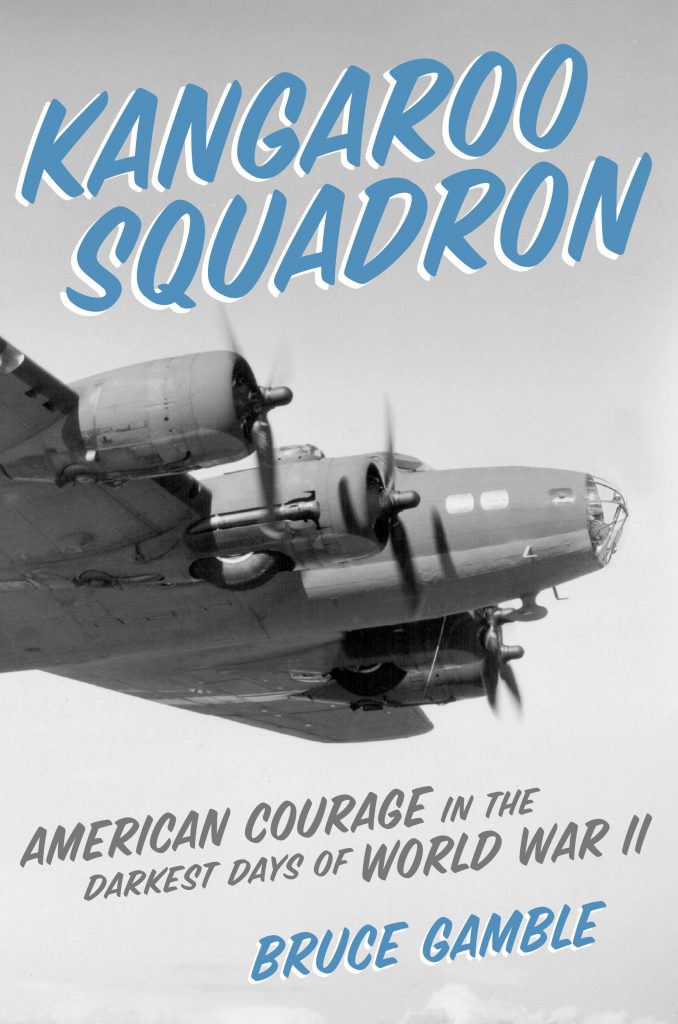I enjoyed reading this book very much. It is very well written and tells a fascinating story about the activities of a US heavy bomber squadron, who had a kangaroo as its mascot, based in northern Australia for much of the first year of the war in the Pacific. One reason this book has much to offer the reader – even a reader not especially interested in aerial warfare – is that this one unit was involved one way or another in many historically significant events which took place in the Pacific area in that period, beginning with the Japanese attack on Pearl Harbour.

Paperback 400pp RRP: $27.99
In the second half of 1941 it became increasingly obvious to the US government that their forces needed to be strengthened in the Philippines and to this end at 9pm on 6th June a squadron of B-17 bombers departed San Francisco bound for the Philippines via Hawaii. The timing of their departure was such that the bombers arrived over Honolulu early in the morning of the 7th of December, at the same time as the first wave of Japanese carrier-borne aircraft were approaching Oahu.
Included in the book is a photograph taken by a B-17 crewmember as it approached Honolulu of two Japanese dive-bombers flying alongside the bomber and heading for the same destination! Although fired on by both Japanese aircraft and American anti-aircraft guns none of the B-17s were shot down, although two crash-landed. The squadron then spent the next two months flying maritime reconnaissance patrols out of Hawaii.
The squadron was ordered to relocate to Townsville in early February 1942 to undertake long range reconnaissance and bombardment, with an initial focus on Simpson Harbour at Rabaul which by then was in Japanese hands. Their first raid on Rabaul took place on February 2nd and was to be followed by many more raids on Rabaul, Lae, Salamaua and other locations in an arc from the Solomons to the Netherlands East Indies, often using Jackson’s Strip (now Jacksons International Airport) at Port Moresby as a staging post. Long distance bombing was not their only activity. In March 1942 one of their aircraft flew to the Philippines to fly Douglas Macarthur together with his family, his staff and senior staff members to Australia (the book dispels some of the Macarthur inspired myths about the trip). Shortly afterwards another of their aircraft brought Philippines President Manuel Quezon to Australia (after a brief stay he moved to the US where he established a Philippines government in exile).
In early May the squadron was involved in the Battle of the Coral Sea undertaking both reconnaissance and bombing missions against Japanese ship and in July of 1942 it carried out important aerial surveillance of Guadalcanal followed by bombing raids against Japanese ships off Buna that were providing support to the Japanese forces making their way over the Kokoda Trail. There then followed a steady flow of reconnaissance and bombing missions, especially against Rabaul, but by late October it had been decided that the squadron should return to the US and become an operational training unit for replacement B-17 personnel.
While that was the end of the story of Kangaroo Squadron, the book does not end at that point. Trying to make its way back to Townsville after the squadron’s very first bombing raid, one of the B-17s crash-landed in a swamp on the north coast of Papua. The last chapter of the book tells the story of the survival of the crew (itself quite remarkable) and the search since the end of the Second World War for the largely-intact wreckage and its eventual removal to Pearl Harbour where it has been reassembled to recreate its appearance in the swamp, bent propellers and all. (A Google search for ‘swamp ghost’ will yield a number of photos and videos of the aircraft.)
The book includes forty B&W photographs, many taken at the squadron’s bases in Townsville and Port Moresby together with eight maps (although many are unnecessary for an Australian reader) showing the SW Pacific area, the Philippines, Papua and New Guinea. The book also has sixteen pages of endnotes, a select bibliography and comprehensive index.
Bruce Gamble is the author of another book of particular interest to Australians, Darkest Hour: the true story of Lark Force at Rabaul – Australia’s worst military disaster of World War II, a copy of which is held in the RUSI (VIC) library.
Reviewed for RUSI by Robert Dixon, March 2019
Contact Royal United Services Institute about this article.






